Answered step by step
Verified Expert Solution
Question
1 Approved Answer
Please help with question #3. Feedback is in blue. Thank you for your help!!! 38 3. Calculate the new NPV and IRR. Should the Project
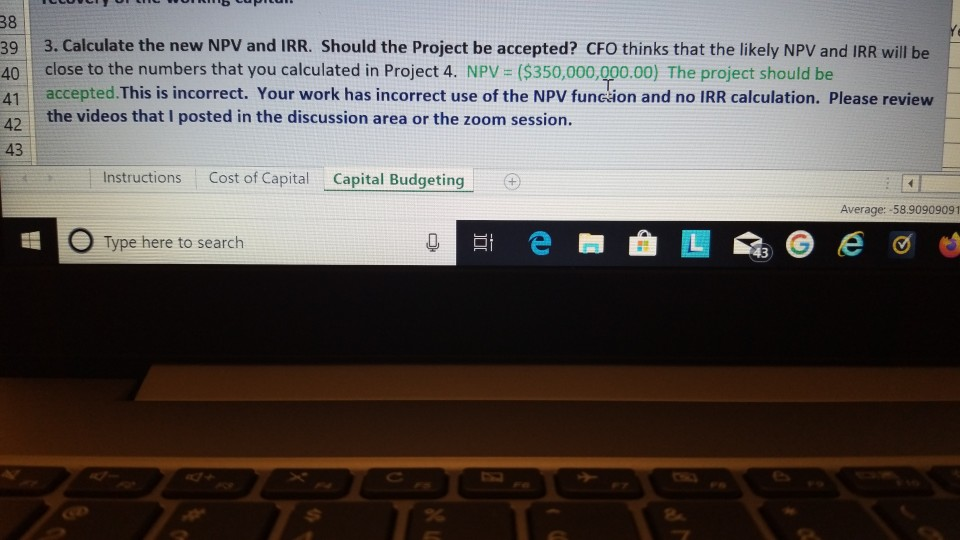
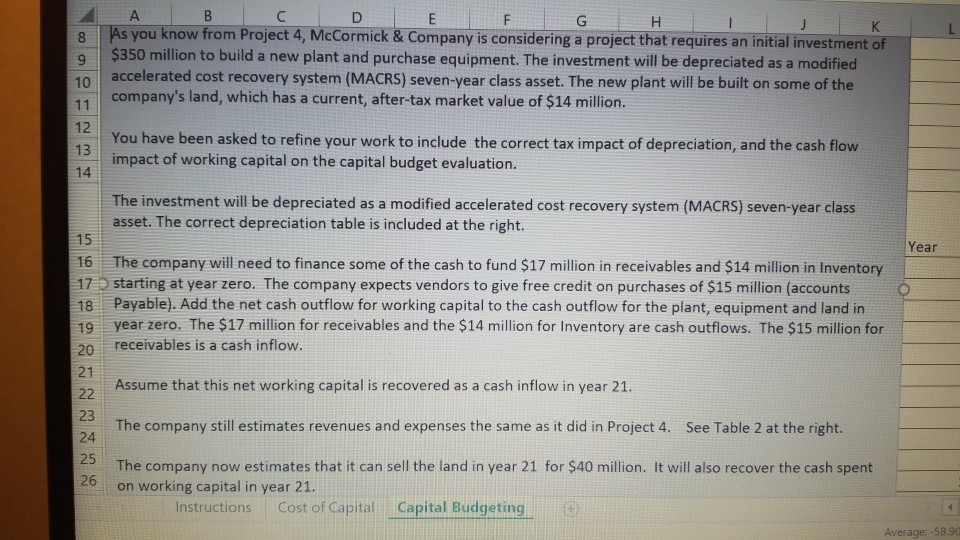
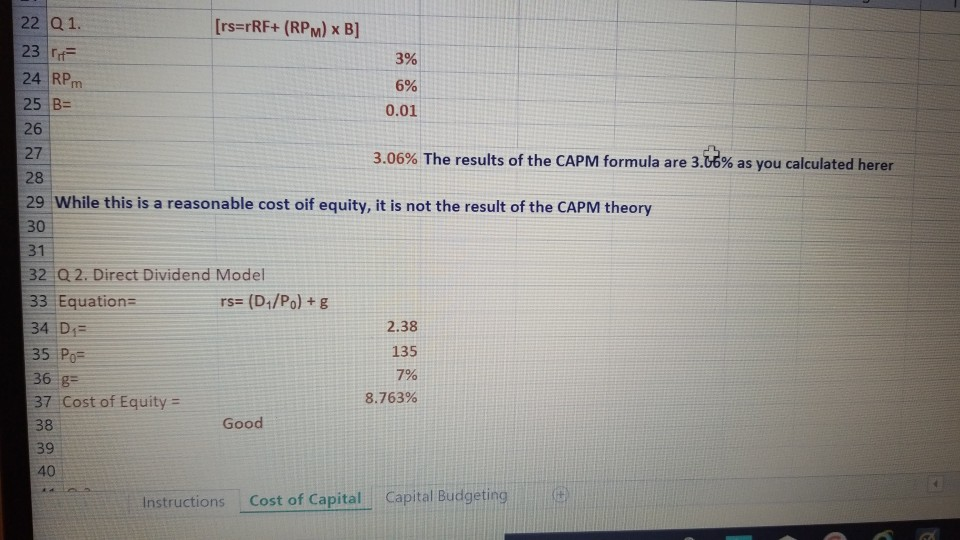
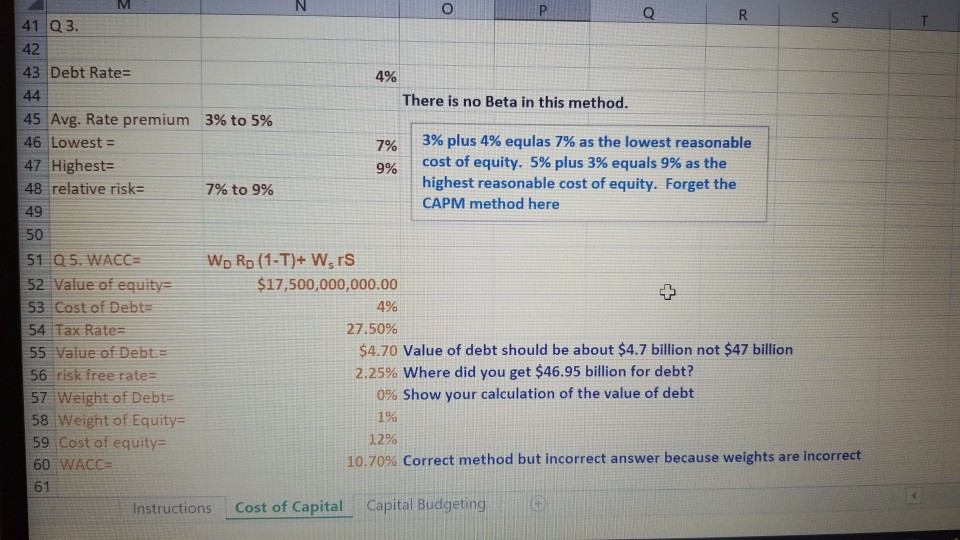
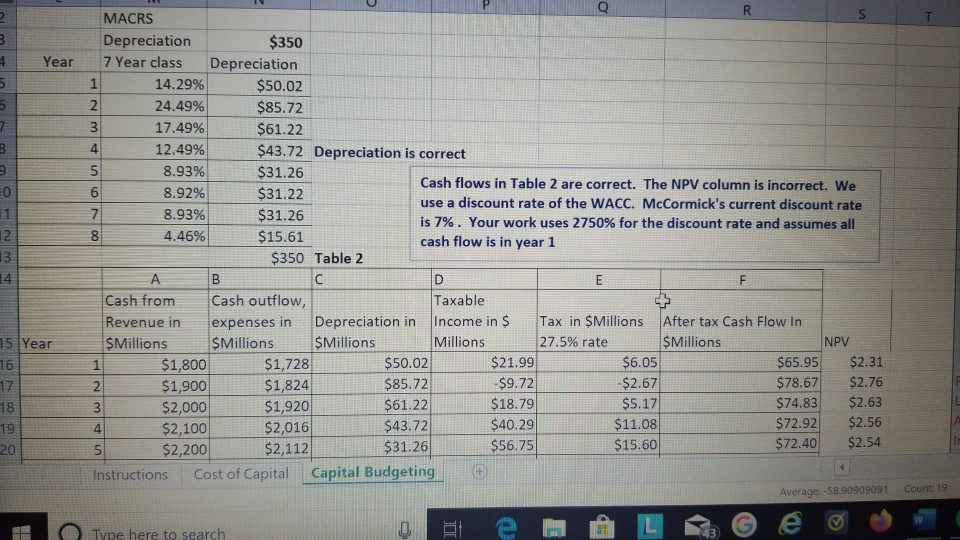

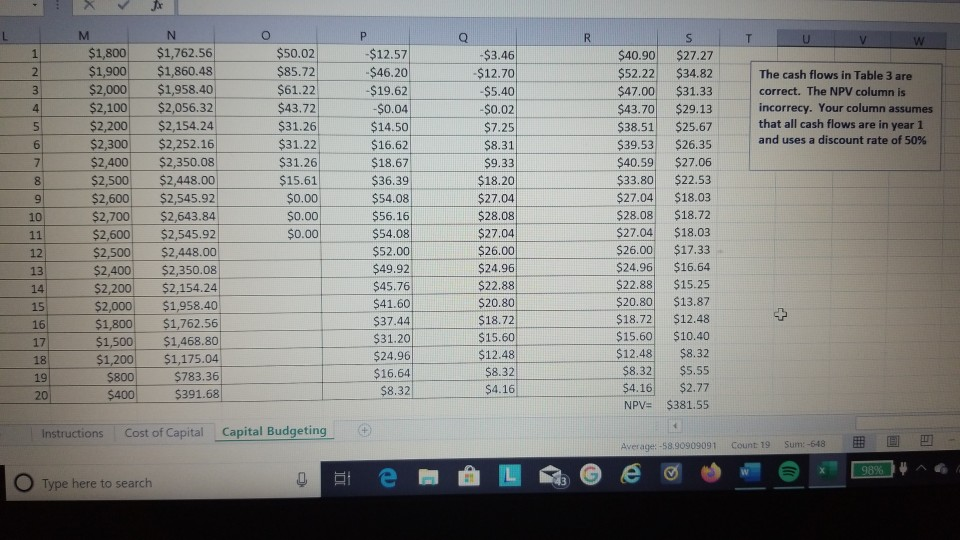
Please help with question #3. Feedback is in blue. Thank you for your help!!!
38 3. Calculate the new NPV and IRR. Should the Project be accepted? CFO thinks that the likely NPV and IRR will be close to the numbers that you calculated in Project 4. NPV = ($350,000,000.00) The project should be 39 40 accepted.This is incorrect. Your work has incorrect use of the NPV funcion and no lRR calculation. Please review 41 the videos that I posted in the discussion area or the zoom session. 42 43 Cost of Capital Instructions Capital Budgeting Average: -58.90909091 Type here to search 43 L5 B H. K As you know from Project 4, McCormick & Company is considering a project that requires an initial investment of $350 million to build a new plant and purchase equipment. The investment will be depreciated as a modified accelerated cost recovery system (MACRS) seven-year class asset. The new plant will be built on some of the 8. 9. 10 company's land, which has a current, after-tax market value of $14 million. 11 12 You have been asked to refine your work to include the correct tax impact of depreciation, and the cash flow 13 impact of working capital on the capital budget evaluation. 14 The investment will be depreciated as a modified accelerated cost recovery system (MACRS) seven-year class asset. The correct depreciation table is included at the right. 15 16 Year The company will need to finance some of the cash to fund $17 million in receivables and $14 million in Inventory starting at year zero. The company expects vendors to give free credit on purchases of $15 million (accounts 18 Payable). Add the net cash outflow for working capital to the cash outflow for the plant, equipment and land in year zero. The $17 million for receivables and the $14 million for Inventory are cash outflows. The $15 million for 17 19 receivables is a cash inflow. 20 21 Assume that this net working capital is recovered as a cash inflow in year 21. 22 23 The company still estimates revenues and expenses the same as it did in Project 4. 24 See Table 2 at the right. 25 The company now estimates that it can sell the land in year 21 for $40 million. It will also recover the cash spent 26 on working capital in year 21. Cost of Capital Capital Budgeting Instructions Average: -58.90 22 Q 1. [rs=rRF+ (RPM) x B] 23 T 3% 24 RPm 6% 25 B= 0.01 26 27 3.06% The results of the CAPM formula are 3.06% as you calculated herer 28 29 While this is a reasonable cost oif equity, it is not the result of the CAPM theory 30 31 32 Q 2. Direct Dividend Model 33 Equation= 34 D= 35 Po= 36 g= 37 Cost of Equity = rs= (D1/Po) + g 2.38 135 7% 8.763% %3D Good 38 39 40 Capital Budgeting Cost of Capital Instructions R. 41 Q 3. 42 43 Debt Rate= 4% 44 There is no Beta in this method. 45 Avg. Rate premium 46 Lowest = 47 Highest= 48 relative risk= 3% to 5% 3% plus 4% equlas 7% as the lowest reasonable cost of equity. 5% plus 3% equals 9% as the highest reasonable cost of equity. Forget the CAPM method here 7% 9% 7% to 9% 49 50 51 Q 5. WACC= 52 Value of equity= 53 Cost of Debt= 54 Tax Rate= 55 Value of Debt.= 56 risk free rate= 57 Weight of Debt= 58 Weight of Equity= 59 Cost of equity= 60 WACC= Wp Rp (1-T)+ W, rs $17,500,000,000.00 4% 27.50% $4.70 Value of debt should be about $4.7 billion not $47 billion 2.25% Where did you get $46.95 billion for debt? 0% Show your calculation of the value of debt 1% 12% 10.70% Correct method but incorrect answer because weights are incorrect 61 Capital Budgeting Cost of Capital Instructions R. MACRS Depreciation 7 Year class $350 Year Depreciation $50.02 14.29% 24.49% $85.72 17.49% $61.22 4 12.49% $43.72 Depreciation is correct $31.26 5. 8.93% Cash flows in Table 2 are correct. The NPV column is incorrect. We use a discount rate of the WACC. McCormick's current discount rate is 7%. Your work uses 2750% for the discount rate and assumes all cash flow is in year 1 8.92% $31.22 $31.26 $15.61 $350 Table 2 8.93% 12 13 14 4.46% B. Cash outflow, Taxable Cash from Revenue in Tax in $Millions Depreciation in Income in $ After tax Cash Flow In SMillions $6.05 -$2.67 expenses in SMillions 15 Year 16 $Millions $1,800 $1,900 $2,000 $2,100 $2,200 27.5% rate Millions SMillions NPV $65.95 $78.67 $74.83 $72.92 $72.40 $21.99 $1,728 $1,824 $1,920 $2,016 $2,112 $2.31 $50.02 $2.76 -$9.72 $85.72 17 $18.79 $40.29 $2.63 $5.17 $61.22 18 3. $11.08 $15.60 $2.56 $43.72 19 20 $2.54 $31.26 $56.75 Capital Budgeting Instructions Cost of Capital Count: 19 Average: -58.90909091 Type here to search DI 1. 2. 3. 00 1. 2. $2,300 $2,400 $2,500 $2,600 $2,700 $2,600 $2,500 $2,400 $2,200 $2,000 $1,800 $1,500 $1,200 $2,208 $2,304 $2,400 $2,496 $2,592 $2,496 $2,400 $2,304 $2,112 $1,920 $1,728 $1,440 $1,152 $768 $31.22 $31.26 $15.61 21 $60.78 $64.75 $84.39 $104.00 $108.00 $104.00 $100.00 $16.71 $75.29 $78.20 $76.79 $75.40 $78.30 $75.40 $72.50 $69.60 $2.64 22 $17.80 $2.74 23 $23.21 $28.60 $29.70 $28.60 $27.50 $2.69 $2.65 24 25 26 10 $2.75 11 $2.65 $2.54 $2.44 $2.24 27 12 $26.40 $24.20 $22.00 13 $96.00 28 $88.00 $80.00 $72.00 $60.00 $63.80 14 29 $58.00 $52.20 $2.04 $1.83 30 15 $19.80 16 31 $43.50 $34.80 $16.50 $13.20 $1.53 17 32 $1.22 $48.00 33 18 $0.81 $23.20 $27.60 NPV= $44.54 Not correct $8.80 $32.00 $800 19 34 $16.00 $0.97 $4.40 $400 $384 20 35 Table 3 36 D. 37 Tax in $Millions 27.5% rate in Taxable Cash outflow, Cash from Depreciation in $Millions years 1, 2, 3 and After tax Cash Flow In Income in $ expenses in SMillions Revenue in NPV $Millions 50% there after Millions SMillions 38 Year Capital Budgeting Cost of Capital Instructions Sun Count 19 Average: -58.90909091 Type here to search R. 7. T. $1,800 $1,900 $2,000 $2,100 $2,200 $1,762.56 $1,860.48 $1,958.40 $2,056.32 $2,154.24 $2,252.16 $2,350.08 $2,448.00 $2,545.92 $2,643.84 $50.02 -$3.46 $40.90 $52.22 $47.00 $43.70 -$12.57 $27.27 $46.20 $85.72 -$12.70 $34.82 The cash flows in Table 3 are $61.22 -$19.62 -$0.04 $14.50 $16.62 $18.67 -$5.40 $31.33 correct. The NPV column is $43.72 incorrecy. Your column assumes that all cash flows are in year 1 -$0.02 $29.13 $31.26 $25.67 $26.35 $27.06 $22.53 $7.25 $38.51 and uses a discount rate of 50% $2,300 $2,400 $2,500 $2,600 $2,700 $2,600 $2,500 $2,400 $2,200 $2,000 $1,800 $1,500 $1,200 $800 $400 $31.22 $8.31 $39.53 $31.26 $40.59 $33.80 $9.33 $15.61 $36.39 $54.08 $18.20 8. $27.04 $18.03 $0.00 $27.04 9. $28.08 $28.08 $18.72 $0.00 $56.16 10 $0.00 $27.04 $18.03 $27.04 $2,545.92 $2,448.00 $2,350.08 $2,154.24 $1,958.40 $1,762.56 $1,468.80 $1,175.04 $783.36 $391.68 $54.08 11 $52.00 $17.33 $16.64 $26.00 $26.00 12 $24.96 $24.96 $49.92 13 $45.76 $22.88 $15.25 $22.88 14 $20.80 $20.80 $13.87 15 $41.60 $18.72 $12.48 $37.44 $18.72 16 $15.60 $10.40 $31.20 $15.60 17 $24.96 $16.64 $12.48 $8.32 $12.48 $8.32 $4.16 18 $5.55 $8.32 19 $4.16 $2.77 $8.32 20 $381.55 NPV= Capital Budgeting Cost of Capital Instructions Sum: -648 Average: -58.90909091 Count 19 98% O Type here to search 38 3. Calculate the new NPV and IRR. Should the Project be accepted? CFO thinks that the likely NPV and IRR will be close to the numbers that you calculated in Project 4. NPV = ($350,000,000.00) The project should be 39 40 accepted.This is incorrect. Your work has incorrect use of the NPV funcion and no lRR calculation. Please review 41 the videos that I posted in the discussion area or the zoom session. 42 43 Cost of Capital Instructions Capital Budgeting Average: -58.90909091 Type here to search 43 L5 B H. K As you know from Project 4, McCormick & Company is considering a project that requires an initial investment of $350 million to build a new plant and purchase equipment. The investment will be depreciated as a modified accelerated cost recovery system (MACRS) seven-year class asset. The new plant will be built on some of the 8. 9. 10 company's land, which has a current, after-tax market value of $14 million. 11 12 You have been asked to refine your work to include the correct tax impact of depreciation, and the cash flow 13 impact of working capital on the capital budget evaluation. 14 The investment will be depreciated as a modified accelerated cost recovery system (MACRS) seven-year class asset. The correct depreciation table is included at the right. 15 16 Year The company will need to finance some of the cash to fund $17 million in receivables and $14 million in Inventory starting at year zero. The company expects vendors to give free credit on purchases of $15 million (accounts 18 Payable). Add the net cash outflow for working capital to the cash outflow for the plant, equipment and land in year zero. The $17 million for receivables and the $14 million for Inventory are cash outflows. The $15 million for 17 19 receivables is a cash inflow. 20 21 Assume that this net working capital is recovered as a cash inflow in year 21. 22 23 The company still estimates revenues and expenses the same as it did in Project 4. 24 See Table 2 at the right. 25 The company now estimates that it can sell the land in year 21 for $40 million. It will also recover the cash spent 26 on working capital in year 21. Cost of Capital Capital Budgeting Instructions Average: -58.90 22 Q 1. [rs=rRF+ (RPM) x B] 23 T 3% 24 RPm 6% 25 B= 0.01 26 27 3.06% The results of the CAPM formula are 3.06% as you calculated herer 28 29 While this is a reasonable cost oif equity, it is not the result of the CAPM theory 30 31 32 Q 2. Direct Dividend Model 33 Equation= 34 D= 35 Po= 36 g= 37 Cost of Equity = rs= (D1/Po) + g 2.38 135 7% 8.763% %3D Good 38 39 40 Capital Budgeting Cost of Capital Instructions R. 41 Q 3. 42 43 Debt Rate= 4% 44 There is no Beta in this method. 45 Avg. Rate premium 46 Lowest = 47 Highest= 48 relative risk= 3% to 5% 3% plus 4% equlas 7% as the lowest reasonable cost of equity. 5% plus 3% equals 9% as the highest reasonable cost of equity. Forget the CAPM method here 7% 9% 7% to 9% 49 50 51 Q 5. WACC= 52 Value of equity= 53 Cost of Debt= 54 Tax Rate= 55 Value of Debt.= 56 risk free rate= 57 Weight of Debt= 58 Weight of Equity= 59 Cost of equity= 60 WACC= Wp Rp (1-T)+ W, rs $17,500,000,000.00 4% 27.50% $4.70 Value of debt should be about $4.7 billion not $47 billion 2.25% Where did you get $46.95 billion for debt? 0% Show your calculation of the value of debt 1% 12% 10.70% Correct method but incorrect answer because weights are incorrect 61 Capital Budgeting Cost of Capital Instructions R. MACRS Depreciation 7 Year class $350 Year Depreciation $50.02 14.29% 24.49% $85.72 17.49% $61.22 4 12.49% $43.72 Depreciation is correct $31.26 5. 8.93% Cash flows in Table 2 are correct. The NPV column is incorrect. We use a discount rate of the WACC. McCormick's current discount rate is 7%. Your work uses 2750% for the discount rate and assumes all cash flow is in year 1 8.92% $31.22 $31.26 $15.61 $350 Table 2 8.93% 12 13 14 4.46% B. Cash outflow, Taxable Cash from Revenue in Tax in $Millions Depreciation in Income in $ After tax Cash Flow In SMillions $6.05 -$2.67 expenses in SMillions 15 Year 16 $Millions $1,800 $1,900 $2,000 $2,100 $2,200 27.5% rate Millions SMillions NPV $65.95 $78.67 $74.83 $72.92 $72.40 $21.99 $1,728 $1,824 $1,920 $2,016 $2,112 $2.31 $50.02 $2.76 -$9.72 $85.72 17 $18.79 $40.29 $2.63 $5.17 $61.22 18 3. $11.08 $15.60 $2.56 $43.72 19 20 $2.54 $31.26 $56.75 Capital Budgeting Instructions Cost of Capital Count: 19 Average: -58.90909091 Type here to search DI 1. 2. 3. 00 1. 2. $2,300 $2,400 $2,500 $2,600 $2,700 $2,600 $2,500 $2,400 $2,200 $2,000 $1,800 $1,500 $1,200 $2,208 $2,304 $2,400 $2,496 $2,592 $2,496 $2,400 $2,304 $2,112 $1,920 $1,728 $1,440 $1,152 $768 $31.22 $31.26 $15.61 21 $60.78 $64.75 $84.39 $104.00 $108.00 $104.00 $100.00 $16.71 $75.29 $78.20 $76.79 $75.40 $78.30 $75.40 $72.50 $69.60 $2.64 22 $17.80 $2.74 23 $23.21 $28.60 $29.70 $28.60 $27.50 $2.69 $2.65 24 25 26 10 $2.75 11 $2.65 $2.54 $2.44 $2.24 27 12 $26.40 $24.20 $22.00 13 $96.00 28 $88.00 $80.00 $72.00 $60.00 $63.80 14 29 $58.00 $52.20 $2.04 $1.83 30 15 $19.80 16 31 $43.50 $34.80 $16.50 $13.20 $1.53 17 32 $1.22 $48.00 33 18 $0.81 $23.20 $27.60 NPV= $44.54 Not correct $8.80 $32.00 $800 19 34 $16.00 $0.97 $4.40 $400 $384 20 35 Table 3 36 D. 37 Tax in $Millions 27.5% rate in Taxable Cash outflow, Cash from Depreciation in $Millions years 1, 2, 3 and After tax Cash Flow In Income in $ expenses in SMillions Revenue in NPV $Millions 50% there after Millions SMillions 38 Year Capital Budgeting Cost of Capital Instructions Sun Count 19 Average: -58.90909091 Type here to search R. 7. T. $1,800 $1,900 $2,000 $2,100 $2,200 $1,762.56 $1,860.48 $1,958.40 $2,056.32 $2,154.24 $2,252.16 $2,350.08 $2,448.00 $2,545.92 $2,643.84 $50.02 -$3.46 $40.90 $52.22 $47.00 $43.70 -$12.57 $27.27 $46.20 $85.72 -$12.70 $34.82 The cash flows in Table 3 are $61.22 -$19.62 -$0.04 $14.50 $16.62 $18.67 -$5.40 $31.33 correct. The NPV column is $43.72 incorrecy. Your column assumes that all cash flows are in year 1 -$0.02 $29.13 $31.26 $25.67 $26.35 $27.06 $22.53 $7.25 $38.51 and uses a discount rate of 50% $2,300 $2,400 $2,500 $2,600 $2,700 $2,600 $2,500 $2,400 $2,200 $2,000 $1,800 $1,500 $1,200 $800 $400 $31.22 $8.31 $39.53 $31.26 $40.59 $33.80 $9.33 $15.61 $36.39 $54.08 $18.20 8. $27.04 $18.03 $0.00 $27.04 9. $28.08 $28.08 $18.72 $0.00 $56.16 10 $0.00 $27.04 $18.03 $27.04 $2,545.92 $2,448.00 $2,350.08 $2,154.24 $1,958.40 $1,762.56 $1,468.80 $1,175.04 $783.36 $391.68 $54.08 11 $52.00 $17.33 $16.64 $26.00 $26.00 12 $24.96 $24.96 $49.92 13 $45.76 $22.88 $15.25 $22.88 14 $20.80 $20.80 $13.87 15 $41.60 $18.72 $12.48 $37.44 $18.72 16 $15.60 $10.40 $31.20 $15.60 17 $24.96 $16.64 $12.48 $8.32 $12.48 $8.32 $4.16 18 $5.55 $8.32 19 $4.16 $2.77 $8.32 20 $381.55 NPV= Capital Budgeting Cost of Capital Instructions Sum: -648 Average: -58.90909091 Count 19 98% O Type here to searchStep by Step Solution
There are 3 Steps involved in it
Step: 1

Get Instant Access to Expert-Tailored Solutions
See step-by-step solutions with expert insights and AI powered tools for academic success
Step: 2

Step: 3

Ace Your Homework with AI
Get the answers you need in no time with our AI-driven, step-by-step assistance
Get Started


